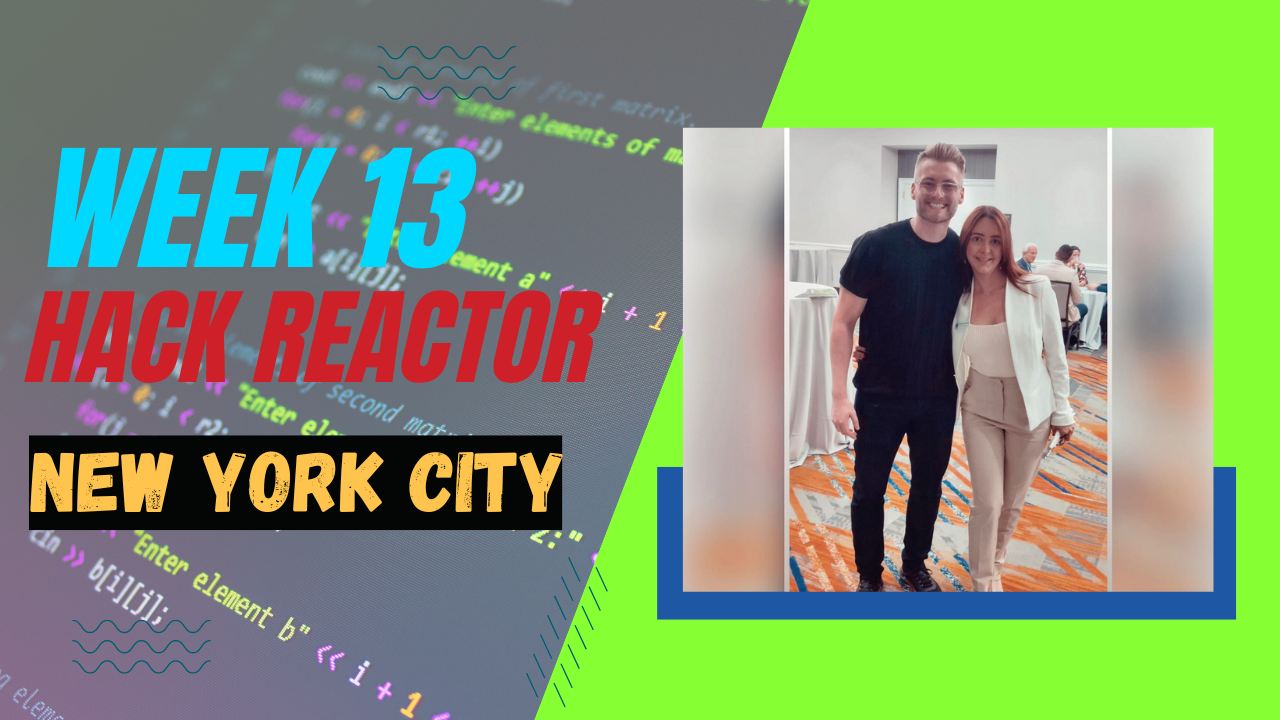From New York City and the start to Module 3
Share
Week 13 was the first time working in the Hack Reactor course while traveling to the United States. This week I accompanied my girlfriend Valeria to New York City for her work at her first conference with the company Family Office Club where she works with. I was super proud of her for creating more opportunities for herself professionally, growing her network, and facing and overcoming new challenges. It was a hot time in the Brooklyn area of New York City during our four days there. I was happy to have many opportunities to enjoy the sunshine and walk around Brooklyn Heights and downtown. Brooklyn area on the breaks I had away from the computer and even met a guest at the conference Val was working at who was also from Alaska! I'm incredibly grateful to have the opportunity to visit New York City for the first time and also be able to work from there, travel with Val, and continually grow our relationship together.
Moving onto this week's learnings and insights from the Week 13 of the Hack Reactor program.
This week was the start of module 3, which had us in groups of 4-5 people and building a complete stack application from incubation to fully working and operating at the end of the module. I'm excited to be in a diverse group of 5 people, and we have great chemistry for focusing on the task at hand and git along with each other, and joking around.
For our project this week, we worked on the first few days creating our idea for an application, wireframing the frontend design and functionality, defining our API endpoints and the data that needs to be returned, and creating issues for the various functions that need to be made for our application to function on the user experience side and doing so using the GitLab platform.
Moving into week 14, we will be bringing to code our project and defining the type of database we will use for our project. Speaking of our project, we are focusing on building an application that displays clothes recommended to a user based on the weather. We will be using, at the minimum, a weather open API with Open Weather and a fashion API or a calendar API. My group members and I are excited about the potential of improving our project after we have met our Minimum Viable Project functionality and have time to work on our stretch goals. I will document more about this and our group project progress over the next several weeks.
In addition to this project starting for Module 3, we are also being introduced to Data Structure and Algorithms. The reason is because of how often interviewees will ask questions relating to this topic, and it can trip up many interviewees. Also, this week we submitted our final resume to receive feedback and improvement from the career services team later in Module 3.
Topics learned this week:
What is a relational database?
A relational database stores and organizes data in tables, where each table represents a specific type of entity, and each row represents a unique instance of that entity. The tables are related by common attributes, allowing for complex queries and data retrieval. Relational databases are widely used in software engineering for their flexibility and scalability.
What is Mongo Database?
MongoDB is a document-oriented NoSQL database program that uses JSON-like documents with optional schemas. It is an open-source and flexible database system that allows for high scalability and performance. MongoDB is commonly used in web applications and provides dynamic queries, indexing, and replication features.
What is Redux?
Redux is an open-source JavaScript library for managing application states, and it works with React and other frontend frameworks to manage conditions predictably and efficiently. Redux is often used in large-scale applications to simplify complex state management and enable time-travel debugging.
What are WebSockets?
Websockets are a communication protocol used in software engineering to provide real-time, two-way communication between a client and a server. They allow for efficient and low-latency data transfer, making them ideal for applications that require continual updates, such as chat applications, multiplayer games, and financial trading platforms.
What are async functions?
Async functions are a type of function in JavaScript that are used to simplify the management of asynchronous code. They allow for more readable and maintainable code by using the await keyword to wait for the resolution of a Promise before moving on to the following line of code. Async functions can also use the try...catch syntax for error handling, making managing errors in asynchronous code more straightforward.
HTTP Request Message
An HTTP request message consists of three parts:
- Request line: This contains the HTTP method, the requested resource, and the HTTP version being used, all separated by spaces.
- Header fields: These optional fields provide additional information about the request, such as the type of data being sent or the user's authentication credentials.
- Message body: This contains any data sent with the request, such as form data or JSON payloads.
In summary, the request line specifies the type of request being made and the resource being requested, the header fields provide additional information about the request, and the message body contains any data being sent with the request.
FastAPIs
FastAPI is a modern, fast (high-performance) web framework for building APIs with Python 3.7+ based on standard Python-type hints. It is designed to be easy to use and to provide high performance, with automatic validation of request and response data, automatic generation of API documentation, and support for asynchronous code. FastAPI is built on Starlette for the web and Pydantic's data parts. It is becoming increasingly popular due to its simplicity, speed, and ease of use.
Nodes & Linked Lists
In software engineering, a node is an individual element in a linked list data structure. Each node contains a value and a pointer to the next node in the list. A linked list is a collection of nodes connected by these pointers. Linked lists are commonly used in computer science for their flexibility and efficiency in certain operations, such as inserting or deleting elements. They can also be used to implement other data structures, such as stacks and queues.
What is a data structure?
A data structure organizes and stores data in a computer to be accessed and used efficiently. Data structures provide a means to effectively manage large amounts of data for various purposes, such as searching and sorting. Data structures include arrays, linked lists, stacks, queues, and trees.
What is a node?
In software engineering, a node is an individual element in a linked list data structure. Each node contains a value and a pointer to the next node in the list.
Moving onto next week, we have a short 4-day week and will be leaning more toward Authentication in application designs, inner joins with databases, data structure transversal, React hooks, and frontend authentication. For the rest of the Hack Reactor course, I will be in Santa Rosa de Cabal. I'm looking forward to staying disciplined and focused on the course and transitioning my time to applying for complete remote jobs and networking in the industry. On to week 14! Nos vemos el pronto!
Ready to work with Xander Clemens?
I'd be happy to discuss your project and how we can work together to create unique, fun and engaging content.
Go ahead and click here to be taken to my business service page and see what I can do for you. Book a call with me now. Looking forward to chatting soon!


